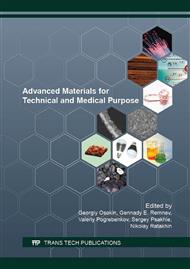[1]
M.I. Joncich, Exploding wires and high-temperature chemistry, Progress in high-temperature physics and chemistry. 3 (1968) 231-254.
Google Scholar
[2]
Yu.A. Kotov, The Electrical Explosion of Wire: A Method for the Synthesis of Weakly Aggregated Nanopowders, Nanotechnologies in Russia. 4(7–8)(2009) 415–424.
DOI: 10.1134/s1995078009070039
Google Scholar
[3]
W. Jiang, K. Yatsui, Pulsed wire discharge for nanosize powder synthesis. IEEE Transactions on Plasma Science. 26(5) (1998) 1498-1501.
DOI: 10.1109/27.736045
Google Scholar
[4]
C. Cho, K. Murai, T. Suzuki, H. Suematsu, W. Jiang, K. Yatsui, Enhancement of energy deposition in pulsed wire discharge for synthesis of nanosized powders, IEEE Transactions on Plasma Science. 32(5) (2004) 2062-(2067).
DOI: 10.1109/tps.2004.835476
Google Scholar
[5]
S. Kwon, Y.H. Jung, N.A. Yavorovsky, A.P. Illyn, J.S. Kim, Ultra-fine powder by wire explosion method, Scripta Mater. 44 (2001) 2247-2251.
DOI: 10.1016/s1359-6462(01)00757-6
Google Scholar
[6]
L.S. Baeva, A.A. Marinin, Modern technologies of additive manufacturing of objects, Vestnik MGTU. 17(1) (2014) 7-12.
Google Scholar
[7]
V.A. Arkhipov, A.G. Korotkikh, V. T. Kuznetsov, A. A. Razdobreev, I. A. Evseenko, Influence of the dispersity of aluminum powder on the ignition characteristics of composite formulations by laser radiation, Russian Journal of Physical Chemistry B. 5(4) (2011).
DOI: 10.1134/s1990793111040026
Google Scholar
[8]
N.V. Svarovskaya , O.V. Bakina, E.A. Glazkova, M. I. Lerner, S. G. Psakh'e, The formation of nanosheets of aluminum oxyhydroxides from electroexposive nanopowders, Russian Journal of Physical Chemistry A. 84(9) (2010) 1566-1569.
DOI: 10.1134/s0036024410090220
Google Scholar
[9]
N.V. Grevtsev, V.D. Zolotukhin, Yu.M. Kashurnikov, V.A. Letyagin, B.I. Makhorin, On copper boiling behavior under pulsed heating by flowing current. High-Temperature Thermal Physics. 15(2) (1977) 362-369.
Google Scholar
[10]
S.N. Kolgatin, M.L. Lev, B.P. Peregud, A.M. Stepanov et al, Explosion of copper conductors under current with a density over 107A/cm2, Technical Physics, 59(9) (1989) 123-132.
Google Scholar


